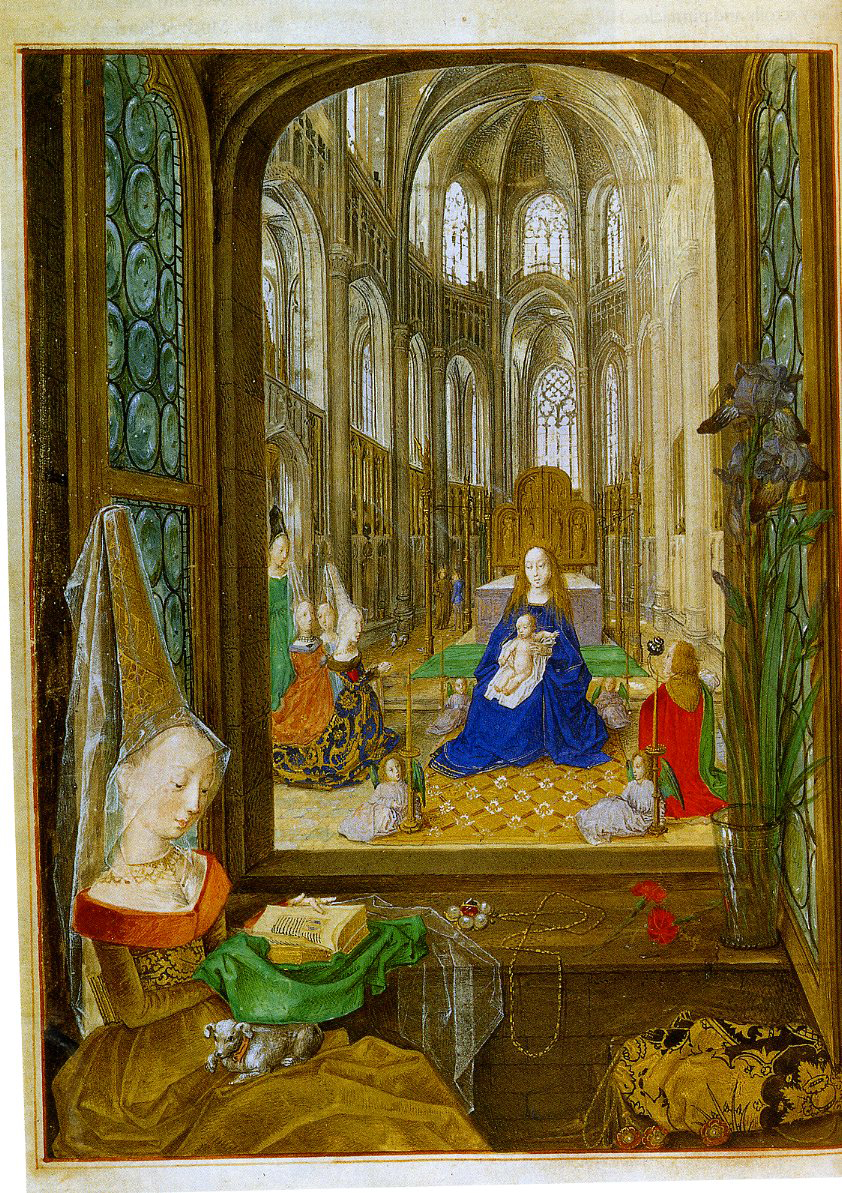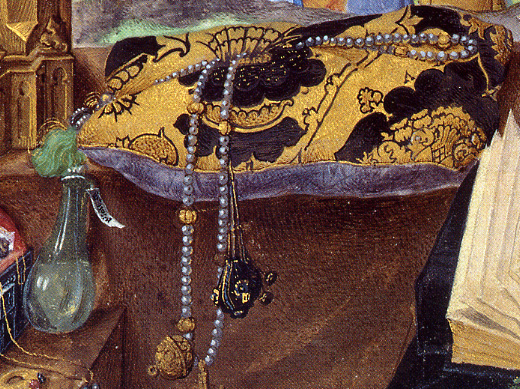The Hours of Mary of Burgundy, is a book of hours arranged for Mary of Burgundy (1457-1482) the daughter of Charles the Bold, Duke of Burgundy (1433-1477, r. 1467-1477). Though the book’s ownership is contested, as several scholars suggest that the book was made for Margaret of York who was Charles’ third wife and Mary’s stepmother, the Hours of Mary of Burgundy, as its name suggests, is most popularly attributed to Mary of Burgundy. Books of hours were based upon medieval breviaries used by various religious groups and clergy to contain their daily prayers. The books of hours were designed to function similarly, however, they were made primarily for lay peoples for use in private devotion. Developed in the thirteenth century and rising to popularity in the fourteenth and fifteenth centuries, due to the increase in lay piety and rising middle classes able to afford to purchase books, books of hours were objects that were intended to reflect the individuality and to symbolize a lay person’s piety and connection to their faith. In addition to their religious purposes, books of hours were ornately decorated in order to represent an indication of its owner’s status within medieval society. Mary’s book of hours, was produced in Flanders around 1477, written in the vernacular, and decorated with twenty full-page miniatures and thirty-two small miniatures. The illustrations are richly adorned with color and beautifully rendered, clearly showing Mary’s status as part of the wealthy elite of medieval European society.
 |
| Mary of Burgundy in Prayer |
The Hours of Mary of Burgundy are an exceptional representation of the increase of lay piety and private devotion in the late middle ages. Books of hours were designed specifically to met the specifications set by those who had them commissioned. By allowing for a greater customization of their intended books, the laity could now specify what they desired to see depicted within the books they had ordered to be made. While Mary’s book of hours was not commissioned by her and was most likely a gift to Mary, the manuscript can, nevertheless, be seen as a reflection of some elements of medieval society’s preferences in their books. Mary herself is depicted in several scenes from the book, most notably in a picture of her reading her book of hours in front of what appears to be a mirror that shows another scene of the Virgin and Child in a church (above). The extent of private devotion that is reflected in such illustrations shows how in depth the relationship with their faith medieval peoples desired. They desired to reach a personal connection through their individual actions of piety that they themselves were in charge of, rather than seeing their relationship with God bourn through the devotions of monks in far off monasteries and priests in their churches. The increase in urbanization, the wider availability of books, increasing “literacy” among lay peoples and even the arguments made by members of heretical orders throughout Europe in the thirteenth, fourteenth and fifteenth centuries allowed people to take on a new role in relation to their religious practices. Though book ownership was still a practice that was dominated primarily by the wealthy due to the cost of making books, the books of hours are a notation of a definitive ideological shift in late medieval culture that placed a greater emphasis on individuality and inclusion in religion outside of the members of the clergy.
 |
| Christ Nailed to the Cross |
 |
| Mary's beads in Christ Nailed to the Cross |
While the books of hours were a powerful representation of the increasing desire for religious piety for lay peoples they were additionally a delineation of status within in medieval society. As I had mentioned previously the commissioning of books and their creation was not a inexpensive undertaking. A book of hours such as Mary of Burgundy’s would have taken a great deal of time, effort and expense to have bound together. The ownership of such a privatized representation of an individual’s faith would have been highly impressive to members of medieval society. The illustrations in the Hours of Mary of Burgundy are extremely impressive, both in their detail and almost ostentatious intermixing of various colors, scenes and personal elements that were desired. Much like the illustration of Mary reading before the mirror, the scene of Christ Nailed to the Cross is fabulously ornate and colored, utilizing a broad array of expensive colors such as blue, gold, and hints of purple. Though it does not possess a depiction of Mary herself, the scene is incredibly detailed and contains other elements that were most likely central to the feeling that the image had been made to emphasize. The string of pearl and gold prayer beads on the pillow and the book of hours represent the means by which Mary, or any reader, was supposed to contemplate the image of Christ’s crucifixion. The beads represent the saying of the Rosary in which Mary would have been expected to recite her Hail Marys in pious meditation of a scene crucial to Christians as their Redemption by Christ. The detail within this image is a perfect representation of the effort and money that went into creating books of hours and why they were be seen as symbols of status for the wealthy elite of medieval Europe.



ReplyDeleteThe Hours of Mary of Burgundy is visual compelling but also a prime example of a fifteenth century book of hours. I particularly enjoy the illumination of Mary of Burgundy at Prayer. The image shows Mary herself sitting with the book of hours praying with fine details such as the jewelry on her table and the fine detail in her clothing. The painting behind her shows the Virgin and Child. Usually with images of the Virgin and Child those included in the scene are often particular saints, the artist, or the patron (or a combination). It is quite likely that Mary of Burgundy was included in the painting within a painting. Though the painting of the Virgin and Child probably was intended to appear not as a painting but as a vision. Mary of Burgundy while praying is shown as having a literal vision of the Virgin, which is an ultimate show of her piety.
The images that you've chosen to highlight are pretty interesting, in that they appear to be set between two cathedral arches (the first one in particular seems to be a window looking down the length of a cathedral) with the images of Mary of Burgundy praying. Though as you have pointed out, the second doesn't actually contain her, but her prayer beads. This combination of church, prayer, and biblical imagery implies a sort of oneness between all of it, as if Mary wanted to show that when she was in prayer, it was just her and the scripture. In addition to that, the second image, it brings to mind the idea of stained glass portraying events from the bible, so her commission must have been very extensive to request this kind of heavy detailing.
ReplyDelete